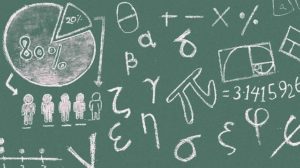Lesson 3.5: Math and Science–Tips for Better Comprehension and for Studying
How to Study Math

Math is one of those subjects that many people struggle with in college. One reason for this is that many students haven’t taken a math class for a few–or many–years and math is one subject that, as the old expression goes, “if you don’t use it, you lose it.” This isn’t always the case, of course. Some people with more “logical/mathematical intelligence” (remember Gardner’s Multiple Intelligences from Unit 1?) enjoy math and seem to easily transition to college level math courses, or at least may not have to take preparatory classes beforehand.
For everyone, however, no matter what the level of math or interest (or lack thereof), there are a number of steps that will help a student achieve greater success. The exercise below will help with this process.
UNIT 3, EXERCISE 5.1
- Read the article How to Study Math. The article features 12 Steps in the study process, 7 Tips that include perspectives to ease common stressors along with a few memory helps and some encouragement, 4 Warnings for further advice and encouragement, and a list of things you will need.
- From all of the advice given in the article, make a list of your personal “Top Twenty Tips for Success in Math Classes”.
How to Study Science
In a previous lesson, we covered some basics when it comes to getting the most out of any textbook. However, science textbooks–and science itself–present a bit more of a challenge. In this subject, there are a lot of specialized words, symbols, and formulas to comprehend and memorize. The following exercise will help you discover your own methods and techniques.
UNIT 3, EXERCISE 5.2
- In a search engine such as Google, type in the key words “how to learn science words, symbols, and formulas.” Add “YouTube” if you prefer to learn from video presentations. Sample search results: “how to memorize the Periodic Table of Elements,” “how to write word equations for chemical reactions,” “word equations examples,” and so on. Scroll through a few pages of these, narrowing your search by looking for subjects you are interested in such as medicine, psychology, biology, botany, anthropology, archaeology, etc.
- From what you found, above, create a list of five resources. Include a very brief summary of the information presented in the resources, and how you think the resources can help you. It might help you organize your thoughts by making a chart such as this:
RESOURCE/SUBJECT/VERY BRIEF SUMMARY/ HOW YOU THINK THIS RESOURCE CAN HELP YOU

